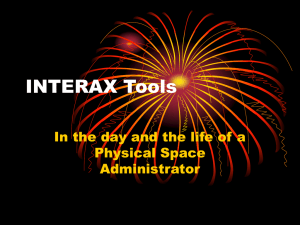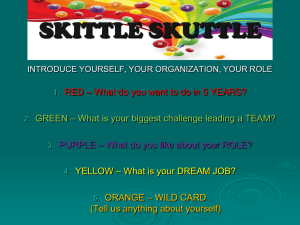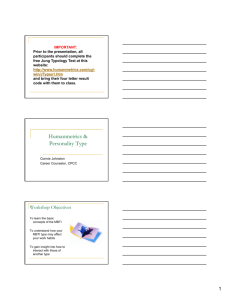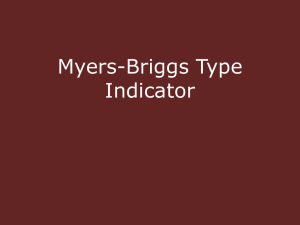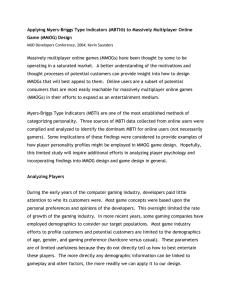Tapping into your leadership skills
advertisement
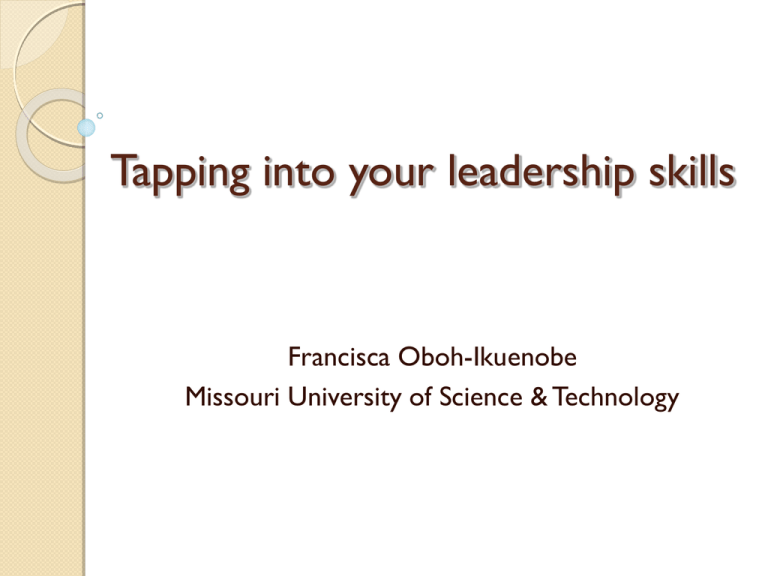
Tapping into your leadership skills Francisca Oboh-Ikuenobe Missouri University of Science & Technology What is Leadership? The ability to guide, direct, or influence people Guidance or direction Office or position of leader Synonyms Management Control Guidance Headship Direction Definition Leadership is a process that unifies diverse groups of people to work effectively as a team toward common purpose under varied and often difficult circumstances, through: the elimination of scapegoating; the maximization of mediation; and the judicious use of power. How will you recognize your leadership style? Common Assessment Tools FIRO-B® (Fundamental Interpersonal Relations Orientation Behavior™) – page 2 of handout —Based on 3 basic interpersonal needs: inclusion, control, affection MBIT® (Myers-Briggs Type Indicator®)** —Based on preferences/behaviors SYMLOG (Systematic Multiple Level Observation of Groups) —Based on ratings by coworkers **We will focus on MBTI The MBIT® Tool ENERGY INFORMATION DECISION LIFESTYLE EXTRAVERSION (E) INTROVERSION (I) Focus on your outside world & get energy through interacting with people and doing things Focus on your inner world & get energy through reflecting on information, ideas, and concepts SENSING (S) INTUITION (I) Notice & trust facts, details, and present realities Attend to & trust interrelationships, theories, & future possibilities THINKING (T) FEELING (F) Make decisions using logical, objective analysis Make decisions to create harmony by applying personcentered values JUDGING (J) PERCEIVING (P) Prefer to be organized & orderly & to make decisions quickly Prefer to be flexible & adaptable & to keep options open See pages 3-5 of handout for additional information Group Exercise (20 minutes) Examining Everyday Behaviors and the MBTI Preferences The extraversion-introversion dichotomy The sensing-intuition dichotomy The thinking-feeling dichotomy The judging-perceiving dichotomy What is your behavior style? As a group, discuss and list examples of how you have seen one of two of these preference dichotomies (assigned) play out at work or home. You can share personal examples of how this preference influences you; or examples of things you have observed in others. Each group will be asked to share a few examples. See pages 6-7 of handout Your Leadership Skill Case study – imagine you as a leader in your unit. Three essential components of successful project management: 1. Running effective meetings 2. Decision making 3. Influencing others The following three slides are left intentionally partially blank for discussion of best practice approaches during the workshop. Running Effective Meetings Maximize the amount of relevant information exchanged Empower the participants Generate good ideas Bring problems to resolution Clarify next steps and accountabilities Best practices approach: Best practices approach How can you ensure extraverts don’t talk too much, and introverts are heard? How can you ensure you engage at the right level of detail, when sensors prefer to look at details and intuitors prefer the big picture? What can you do to be sure information is efficiently exchanged while an appropriate amount of relationship building is going on? What can you do to stay on task without blocking new ideas or opportunities? How can you exert enough control in the meeting while empowering others to take ownership? Additional points to consider? Influencing Your success depends on others, and you influence these people on a regular basis. Depending on how well you do this, people will be motivated to help you succeed … or not. How can you best influence others in a way that helps you advance your goals; build relationships and communicate with key people in your network to build loyalty and a feeling of collaboration? Best practices approach: Best practices approach How can you present project / change initiatives in a way that energizes both extraverts and introverts? How can you craft “hooks” to build interest and motivation around an opportunity that would appeal to a fact-based, here and now perspective (sensor) versus a big picture, bluesky thinker (intuitor)? How could you combine these approaches into one presentation (or memo, etc.)? How can you best answer “what’s in it for me” (WIFIM) when you approach your peers about an opportunity to collaborate, without knowing their MBTI type or FIIRO-B profile? How can you attempt to make requests or assign roles in a way that plays to people’s strengths (e.g., networking, organizing and planning)? Quality Decision Making You’re faced with many decisions every day – some you make without much pause for thoughts, others you may ponder on and off for days. Even when you put decisions off you’re making a choice about how to handle the problem. How can you ensure you’re making high quality decisions? Best practices approach: Best practices approach How can you best ensure the decisions you make are well informed? That is, how can you be sure you have considered the issue from the different type “lenses” – sensing, intuition, thinking, and feeling? How can you encourage those reporting to you that they do the same? What can you do to balance the need for thorough research with timeliness? What can you do to ensure others feel welcome to come to you with conflicting data, rather than just telling you what they think you want to hear? To what extent does discipline play a role in good decision making? How can you ensure discipline is exercised when you make independent decisions? When you are making decisions with a group? Goals and Action Plans Goals: There are so many ways to set goals. One strategy is to follow the creation of “SMART” goals, which have the following characteristics: - Specific - Measurable - Actionable - Relevant - Time-Bound Barriers: For each goal, identify potential barriers to attainment (e.g., hectic travel schedule; difficult timelines; etc.). Beginning Steps: For each goal, make a list of how you plan to begin accomplishing the goal. See pages 8-9 of handout for suggested sequence and rationale in project planning See page 10 for extra information on leadership Leadership Development Goals Write below drafts of two development goals that you are committed to accomplishing over the next year. Link each goal with specific actions that will not only help improve your development areas, but will boost your strengths as well. Effective communication is important for success. _________________________________________________________________________ Goal One Goal Statement: Possible Barriers: Beginning Steps: _________________________________________________________________________ Goal Two Goal Statement: Possible Barriers: Beginning Steps: Resources Waterman & Rogers, 1996: Introduction to the FIRO_B. Consulting Psychological Press. Roger R. Pearlman, 2001: The Leadership Advantage Using the MBTI Tool for Effective Leadership. Consulting Psychological Press. Human Synergistics International, http://www.humansynergistics.com/site/default.aspx Univ. of Missouri Academic Leadership Development Program. SYMLOG Consulting Group, San Diego, CA.
